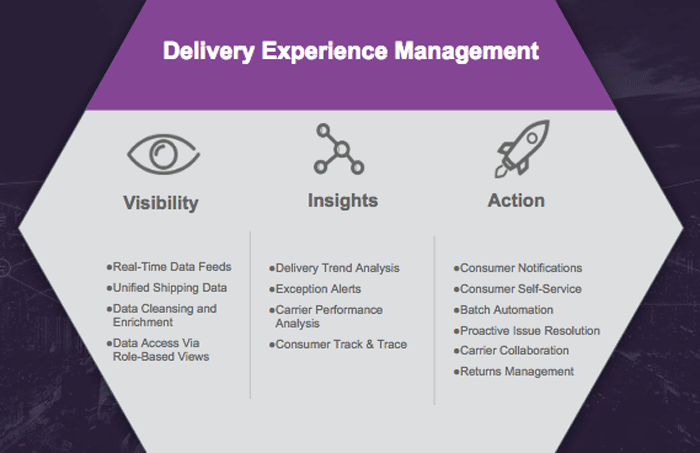Kirsten Newbold-Knipp, CMO, Convey Inc., examines the role of delivery experience management in ensuring a smooth delivery process and keeping customers happy.
E-commerce has skyrocketed over the last 20 years, requiring retail supply chain leaders to step forward and pave the way for a consumer-centric delivery system. This growth, coupled with the ‘Amazon effect’, means supply chain has a bigger impact than ever on where consumers shop, how much they buy, and if they will come back.
Both retailers and carriers across the UK have responded to Amazon’s call for fast, free delivery and ever-convenient experiences by fortifying their own delivery services for consumers. Retailers such as ASOS and Tesco have responded in full, with initiatives like ‘Instant delivery’ to keep up with services such as Prime Now.
Carriers such as DPDgroup provide customers with convenient options such as in-transit changes and one-hour delivery windows to compete with Amazon. And at the end of May, Royal Mail vowed to invest £1.8bn (US$2.2bn) in delivery services such as next-day delivery, that will help customers get their deliveries how and when they expect.

A race to the bottom
Amazon’s ability to provide fast, free shipping to customers has amplified the stakes for retailers, and taught consumers to balk at anything less than a seamless customer experience.
According to a recent shipping survey of 1,500 shoppers across the UK, conducted by Convey, Inc., 96% of consumers agree that shipping experience has an impact on their loyalty. Customers tend to remember negative delivery experiences forever, with 79% saying they are at least somewhat unlikely to return to a brand after just one shipping hiccup. After all, there are endless delivery options for them to choose from.
Delivery exceptions such as delays and damages affect 11% of all last-mile deliveries, and they can make this critical part of the customer journey a confusing time for shoppers. As brands and carriers alike continue to race to the bottom to win over customer loyalty, small-scale tactics, such as adding another shipping option or reactively doling out customer discounts when issues come up, are unsustainable.
These tactics may help retailers stay afloat in the short-term by luring back a few shoppers, but at a high cost to margins due to reactive process inefficiencies.
Brands are spending £2-£9 (US$2.50-US$11.40) per ‘Where is my order’ (WISMO) call, incurring countless transportation costs from terminal holding and return-to-sender fees, and incurring costly refunds for delayed or damaged goods. These exceptions do not have to be the ‘cost of doing business’. Reacting to an upset customer means that it is already too late.
Because the last mile is filled with variables that retailers can’t control, winning retailers are taking a more proactive approach to delivery, minimizing the effect of exceptions on consumers, and saving time and money.
Visibility, analytics and the ability to take action – delivery experience management (DEM) – enable retailers to reduce operational costs, streamline transportation, and uphold delivery promises. Three recent examples of successful DEM are:
- Bodybuilding.com uses DEM to proactively combat exceptions before they impact customers. As a result, the company has reduced WISMO calls by 27% and increased customer satisfaction by boosting NPS by over 6%.
- A leading home improvement retailer is using DEM to collaborate with customers and carriers to resolve exceptions four times faster.
- Grove Collaborative’s team uses DEM to scale its shipping volume while keeping exceptions low. Its team of 70 tackles over 110,000 shipping exceptions per month, saving £51 (US$64.60) per damage claim and £18 (US$22.80) per incorrect address.
By proactively satisfying customer demands, brands are reaping the benefits of a boosted top-line, more efficient transportation, and of course – happier customers.
About the author
 Kirsten Newbold-Knipp has more than 15 years of senior marketing leadership experience at Fortune 100 companies and high-growth startups, including HubSpot, SolarWinds and BigCommerce. Most recently she was research vice president at Gartner, where she advised CMOs on refining strategy, organization and martech priorities. Newbold-Knipp oversees Convey’s corporate brand and messaging initiatives while scaling marketing support for repeatable pipeline and revenue growth.
Kirsten Newbold-Knipp has more than 15 years of senior marketing leadership experience at Fortune 100 companies and high-growth startups, including HubSpot, SolarWinds and BigCommerce. Most recently she was research vice president at Gartner, where she advised CMOs on refining strategy, organization and martech priorities. Newbold-Knipp oversees Convey’s corporate brand and messaging initiatives while scaling marketing support for repeatable pipeline and revenue growth.


